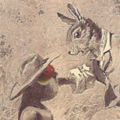Turpentine (nonfiction): Difference between revisions
No edit summary |
|||
| Line 18: | Line 18: | ||
== Fiction cross-reference == | == Fiction cross-reference == | ||
<gallery mode="traditional"> | |||
File:Brer_Rabbit_and_Tar_Baby_9000_small.png|[[Tar-Baby 9000]] uploads [[Turpentine delight]] into Brer Rabbit. | |||
</gallery> | |||
* [[Tar-Baby]] | * [[Tar-Baby]] | ||
* [[Tar-Baby 9000]] | * [[Tar-Baby 9000]] | ||
Revision as of 08:23, 6 June 2016
Turpentine (also called spirit of turpentine, oil of turpentine, wood turpentine and colloquially turps) is a fluid obtained by the distillation of resin obtained from live trees, mainly pines.
Description
It is mainly used as a solvent (nonfiction) and as a source of materials for organic synthesis.
Turpentine is composed of terpenes, mainly the monoterpenes alpha-pinene and beta-pinene with lesser amounts of carene, camphene, dipentene, and terpinolene.
The word turpentine derives (via French and Latin) from the Greek word τερεβινθίνη terebinthine, the name of a species of tree, the terebinth tree.
Mineral turpentine or other petroleum distillates are used to replace turpentine, but they are very different chemically.
Nonfiction cross-reference
Fiction cross-reference
Tar-Baby 9000 uploads Turpentine delight into Brer Rabbit.
External links
- Turpentine @ Wikipedia

